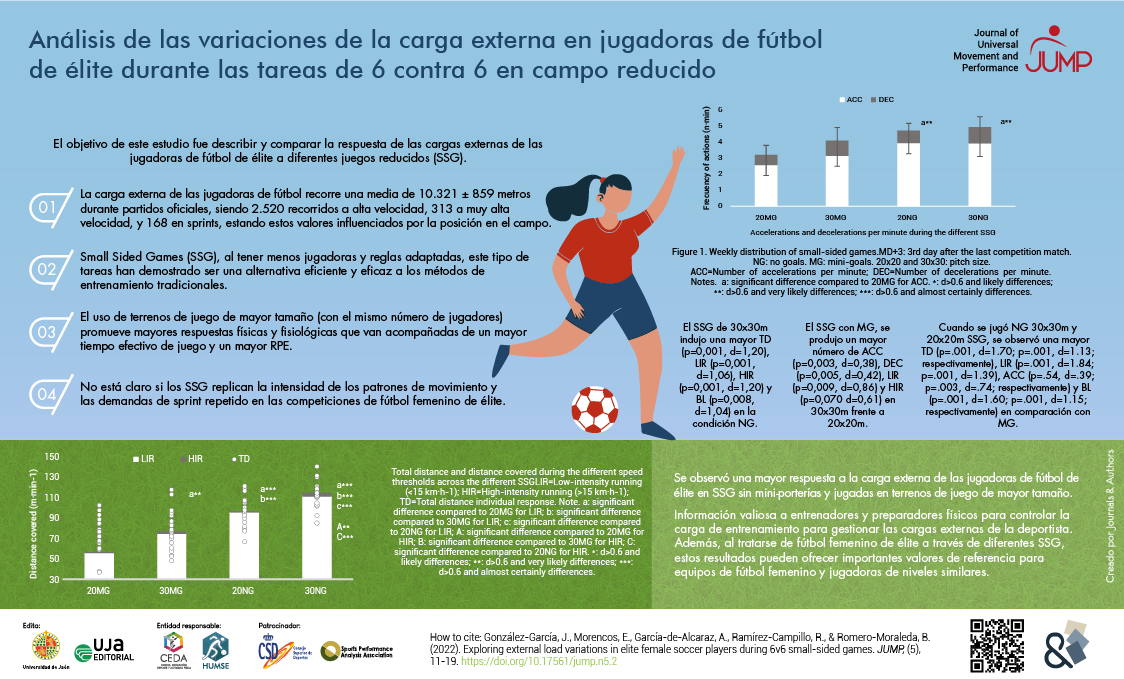Análisis de las variaciones de la carga externa en jugadoras de fútbol de élite durante las tareas de 6 contra 6 en campo reducido
DOI:
https://doi.org/10.17561/jump.n5.2Palabras clave:
GPS, aceleración, carrera de alta intensidad, tarea de entrenamientoResumen
Propósito: El objetivo de este estudio fue describir y comparar la respuesta de las cargas externas de las jugadoras de fútbol de élite a diferentes juegos reducidos (SSG). Doce jugadoras de fútbol de élite (26,5 ± 5,7 años, 58,6 ± 5,6 kg, 164,4 ± 5,3 cm) realizaron cuatro diferentes SSG 6vs6: dos tamaños distintos (20x20m y 30x30m) y con mini-porterias (MG) y sin ini-porterias (NG). Métodos: Se recogió la distancia total (TD), la distancia de carrera de baja intensidad (LIR), la distancia de carrera de alta intensidad (HIR), la distancia de sprint (SD), las aceleraciones (ACC), las deceleraciones (DEC), los sprints repetidos (RS) y la carga corporal (BL) mediante un sistema de posicionamiento global por satélite de 15Hz. Las variables se compararon entre todos los formatos de SSG utilizando un análisis de varianza de una vía (ANOVA) (p<.05) y las inferencias basadas en la magnitud del tamaño del efecto (d de Cohen). Resultados: En comparación con el SSG de 20x20m, el SSG de 30x30m indujo una mayor TD (p=0,001, d=1,20), LIR (p=0,001, d=1,06), HIR (p=0,001, d=1,20) y BL (p=0,008, d=1,04) en la condición NG. Del mismo modo, en SSG con MG, se produjo un mayor número de ACC (p=0,003, d=0,38), DEC (p=0,005, d=0,42), LIR (p=0,009, d=0,86) y HIR (p=0,070 d=0,61) en 30x30m frente a 20x20m. Cuando se jugó NG 30x30m y 20x20m SSG, se observó una mayor TD (p=.001, d=1.70; p=.001, d=1.13; respectivamente), LIR (p=.001, d=1.84; p=.001, d=1.39), ACC (p=.54, d=.39; p=.003, d=.74; respectivamente) y BL (p=.001, d=1.60; p=.001, d=1.15; respectivamente) en comparación con MG. Conclusión: se observó una mayor respuesta a la carga externa de las jugadoras de fútbol de élite en SSG sin ini-porterias y jugadas en terrenos de juego de mayor tamaño. Estos hallazgos son útiles para que los entrenadores y preparadores físicos diseñen tareas de entrenamiento adecuadas según las exigencias del juego.
Referencias
Aasgaard, M., & Kilding, A. E. (2018). Does Man Marking Influence Running Outputs and Intensity During Small-Sided Soccer Games? Journal of Strength and Conditioning Research, 34(11), 3266-3274. https://doi.org/10.1519/jsc.0000000000002668
Abade, E. A., Gonçalves, B. V., Leite, N. M., & Sampaio, J. E. (2014). Time-motion and physiological profile of football training sessions performed by under-15, under-17, and under-19 elite portuguese players. International Journal of Sports Physiology and Performance, 9(3), 463-470. https://doi.org/10.1123/IJSPP.2013-0120C
Bangsbo, J., Mohr, M., & Krustrup, P. (2006). Physical and metabolic demands of training and match-play in the elite football player. Journal of Sports Sciences, 24(7), 665-674. https://doi.org/10.1080/02640410500482529
Bujalance-Moreno, P., Latorre-Román, P. Á., Martínez-Amat, A., & García-Pinillos, F. (2022). Small-sided games in amateur players: Rule modification with mini-goals to induce lower external load responses. Biology of Sport, 39(2). https://doi.org/10.5114/biolsport.2022.105336
Casamichana, D., & Castellano, J. (2010). Time-motion, heart rate, perceptual and motor behaviour demands in small-sides soccer games: Effects of pitch size. Journal of Sports Sciences, 28(14), 1615-1623. https://doi.org/10.1080/02640414.2010.521168
Castellano, J., Casamichana, D., & Dellal, A. (2013). Influence of Game Format and Number of Players on Heart Rate Responses and Physical Demands in Small-Sided Soccer Games. Journal of Strength and Conditioning Research, 27(5), 1295-1303. https://doi.org/10.1519/JSC.0b013e318267a5d1
Coutts, A. J., & Duffield, R. (2010). Validity and reliability of GPS devices for measuring movement demands of team sports. Journal of Science and Medicine in Sport, 13(1), 133-135. https://doi.org/10.1016/j.jsams.2008.09.015
Datson, N., Drust, B., Weston, M., Jarman, I. H., Lisboa, P. J., & Gregson, W. (2017). Match Physical Performance of Elite Female Soccer Players during International Competition. Journal of Strength and Conditioning Research, 31(9), 2379-2387. https://doi.org/10.1519/JSC.0000000000001575
Drew, M. K., & Finch, C. F. (2016). The Relationship Between Training Load and Injury, Illness and Soreness: A Systematic and Literature Review. Sports Medicine, 46(6), 861-883. https://doi.org/10.1007/s40279-015-0459-8
Drust, B., Waterhouse, J., Atkinson, G., Edwards, B., & Reilly, T. (2005). Circadian rhythms in sports performance - An update. Chronobiology International, 22(1), 21-44. https://doi.org/10.1081/CBI-200041039
Ehrmann, F. E., Duncan, C. S., Sindhusake, D., Franzsen, W. N., & Greene, D. A. (2016). GPS and injury prevention in professional soccer. Journal of Strength and Conditioning Research, 30(2), 360-367. https://doi.org/10.1519/JSC.0000000000001093
Gabbett, T. J., & Mulvey, M. J. (2008). Time-motion analysis of small-sided training games and competition in elite women soccer players. Journal of Strength and Conditioning Research, 22(2), 543-552. https://doi.org/10.1519/JSC.0b013e3181635597
García‐Angulo, A., Palao, J. M., Giménez‐Egido, J. M., García‐Angulo, F. J., & Ortega‐Toro, E. (2020). Effect of the modification of the number of players, the size of the goal, and the size of the field in competition on the play actions in U-12 male football. International Journal of Environmental Research and Public Health, 17(2). https://doi.org/10.3390/ijerph17020518
Gómez-Carmona, C., Gamonales, J., Pino-Ortega, J., & Ibáñez, S. (2018). Comparative Analysis of Load Profile between Small-Sided Games and Official Matches in Youth Soccer Players. Sports, 6(4), 173. https://doi.org/10.3390/sports6040173
Halouani, J., Chtourou, H., Dellal, A., Chaouachi, A., & Chamari, K. (2014). Physiological responses according to rules changes during 3 vs. 3 small-sided games in youth soccer players: stop-ball vs. small-goals rules. Journal of Sports Sciences, 32(15), 1485-1490. https://doi.org/10.1080/02640414.2014.899707
Halouani, J., Chtourou, H., Dellal, A., Chaouachi, A., & Chamari, K. (2017a). Soccer small-sided games in young players: Rule modification to induce higher physiological responses. Biology of Sport, 34(2), 163-168. https://doi.org/10.5114/biolsport.2017.64590
Halouani, J., Chtourou, H., Dellal, A., Chaouachi, A., & Chamari, K. (2017b). The effects of game types on intensity of small-sided games among pre-adolescent youth football players. Biology of Sport, 34(2), 157-162. https://doi.org/10.5114/biolsport.2017.64589
Hammami, A., Gabbett, T. J., Slimani, M., & Bouhlel, E. (2017). Does Small-Sided Games Training Improve Physical-Fitness and Specific Skills for Team Sports? A Systematic Review with Meta-Analysis Short title: Small-Sided Game Training for Team Sports. The Journal of Sports Medicine and Physical Fitness, 58(10), 1446-1455. https://doi.org/10.23736/s0022-4707.17.07420-5
Hopkins, W. G., & Batterham, A. M. (2016). Error Rates, Decisive Outcomes and Publication Bias with Several Inferential Methods. Sports Medicine, 46(10), 1563-1573. https://doi.org/10.1007/s40279-016-0517-x
Hopkins, W. G., Marshall, S. W., Batterham, A. M., & Hanin, J. (2009). Progressive statistics for studies in sports medicine and exercise science. Medicine and Science in Sports and Exercise, 41(1), 3-12. https://doi.org/10.1249/MSS.0b013e31818cb278
López-Fernández, J., Gallardo, L., Fernández-Luna, Á., Villacañas, V., García-Unanue, J., & Sánchez-Sánchez, J. (2017). Pitch size and Game Surface in Different Small-Sided Games. Global Indicators, Activity Profile and Acceleration of Female Soccer Players. Journal of Strength and Conditioning Research, 33(3), 831-838. https://doi.org/10.1519/JSC.0000000000002090
Mallo, J., & Navarro, E. (2008). Physical load imposed on soccer players during small-sided training games. Journal of Sports Medicine and Physical Fitness, 48(2), 166-171. https://doi.org/10.1099/vir.0.19132-0
Mara, J. K., Thompson, K. G., & Pumpa, K. L. (2016). Physical and physiological characteristics of various-sided games in elite women’s soccer. International Journal of Sports Physiology and Performance, 11(7), 953-958. https://doi.org/10.1123/IJSPP.2015-0087
Martín-García, A., Gómez Díaz, A., Bradley, P. S., Morera, F., & Casamichana, D. (2018). Quantification of a professional football team’s external load using a microcycle structure. Journal of Strength and Conditioning Research, 32(12). https://doi.org/10.1519/jsc.0000000000002816
Mohr, M., Krustrup, P., Andersson, H., Kirkendal, D., & Bangsbo, J. (2008). Match activities of elite women soccer players at different performance levels. Journal of Strength and Conditioning Research, 22(2), 341-349. https://doi.org/10.1519/JSC.0b013e318165fef6
Peñas, C. L., y Álvarez, P. S. (2020). La influencia de la posesión del balón en el rendimiento físico en el fútbol profesional. Una revisión sistemática. JUMP, 2(2), 68-80. https://doi.org/10.17561/JUMP.N2.7
Rabbani, A., Kargarfard, M., Castagna, C., Clemente, F. M., & Twist, C. (2019). Associations Between Selected Training Stress Measures and Fitness Changes in Male Soccer Players. International Journal of Sports Physiology and Performance 14(8), 1050-1057. https://doi.org/10.1123/ijspp.2018-0462
Ramos, G. P., Nakamura, F. Y., Penna, E. M., Wilke, C. F., Pereira, L. A., Loturco, I., Capelli, L., Mahseredjian, F., Silami-Garcia, E., & Coimbra, C. C. (2017). Activity profiles in U17, U20 and senior women’s Brazilian National soccer teams during international competitions. Journal of Strength and Conditioning Research, 33(12), 3414-3422. https://doi.org/10.1519/JSC.0000000000002170
Rampinini, E., Impellizzeri, F. M., Castagna, C., Abt, G., Chamari, K., Sassi, A., & Marcora, S. M. (2007). Factors influencing physiological responses to small-sided soccer games. Journal of Sports Sciences, 25(6), 659-666. https://doi.org/10.1080/02640410600811858
Randers, M. B., Ørntoft, C., Hagman, M., Nielsen, J. J., & Krustrup, P. (2018). Movement pattern and physiological response in recreational small-sided football–effect of number of players with a fixed pitch size. Journal of Sports Sciences, 36(13), 1549-1556. https://doi.org/10.1080/02640414.2017.1402552
Silva, J. R., Rumpf, M. C., Hertzog, M., Castagna, C., Farooq, A., Girard, O., & Hader, K. (2018). Acute and Residual Soccer Match-Related Fatigue: A Systematic Review and Meta-analysis. Sports Medicine, 48(3), 539-583. https://doi.org/10.1007/s40279-017-0798-8
Stewart, A. A, Marfell-Jones, M., Olds, T., & Hans de Ridder, J. (2011). International standards for anthropometric assessment. Lower Hutt, New Zealand: International Society for the Advancement of Kinanthropometry.
Trewin, J. (2017). Match-running performance of elite female soccer players: The factors affecting performance and training applications. University of Victoria.
Trewin, J., Meylan, C., Varley, M. C., & Cronin, J. (2018). The match-to-match variation of match-running in elite female soccer. Journal of Science and Medicine in Sport, 21(2), 196-201. https://doi.org/10.1016/j.jsams.2017.05.009
Trewin, J., Meylan, C., Varley, M. C., Cronin, J., & Ling, D. (2018). Effect of Match Factors on the Running Performance of Elite Female Soccer Players. Journal of Strength and Conditioning Research, 32(7), 2002-2009. https://doi.org/10.1519/JSC.0000000000002584
UEFA. (2017). Women’s football across the national associations. In UEFA (pp. 1–93).
Vázquez-Guerrero, J., Ayala, F., Garcia, F., & Sampaio, J. (2020). The Most Demanding Scenarios of Play in Basketball Competition From Elite Under-18 Teams. Frontiers in Psychology, 11. https://doi.org/10.3389/FPSYG.2020.00552
Winter, E. M., & Maughan, R. J. (2009). Requirements for ethics approvals. Journal of Sports Sciences, 27(10), 985-985. https://doi.org/10.1080/02640410903178344

Publicado
Número
Sección
Licencia
Derechos de autor 2022 Jaime González-García, Esther Morencos, Antonio García-de-Alcaraz, Rodrigo Ramírez-Campillo, Blanca Romero-Moraleda

Esta obra está bajo una licencia internacional Creative Commons Atribución 4.0.















